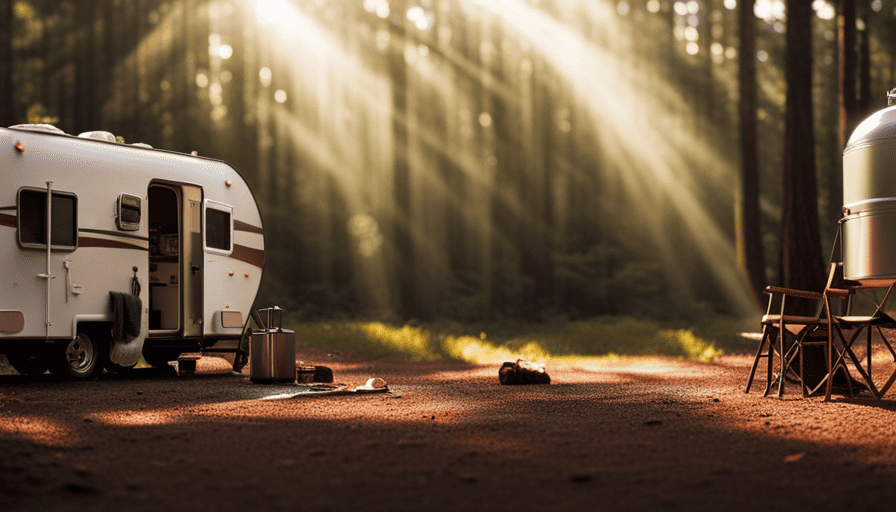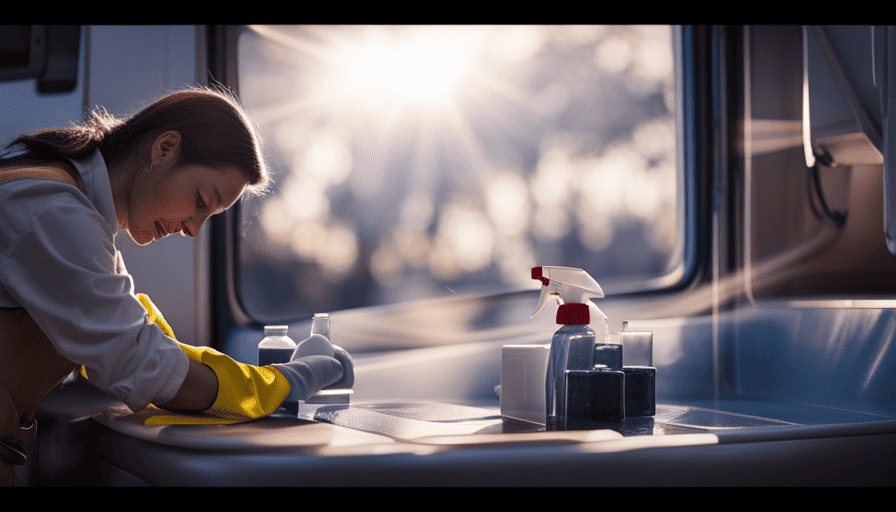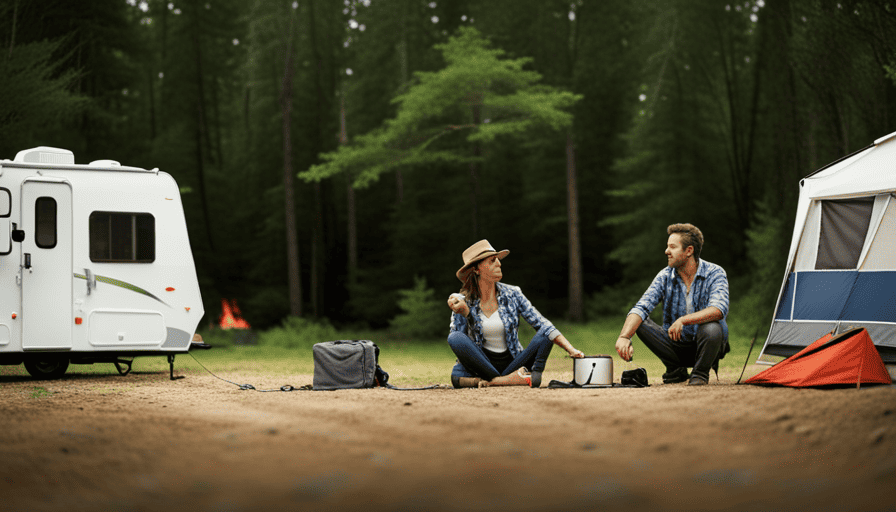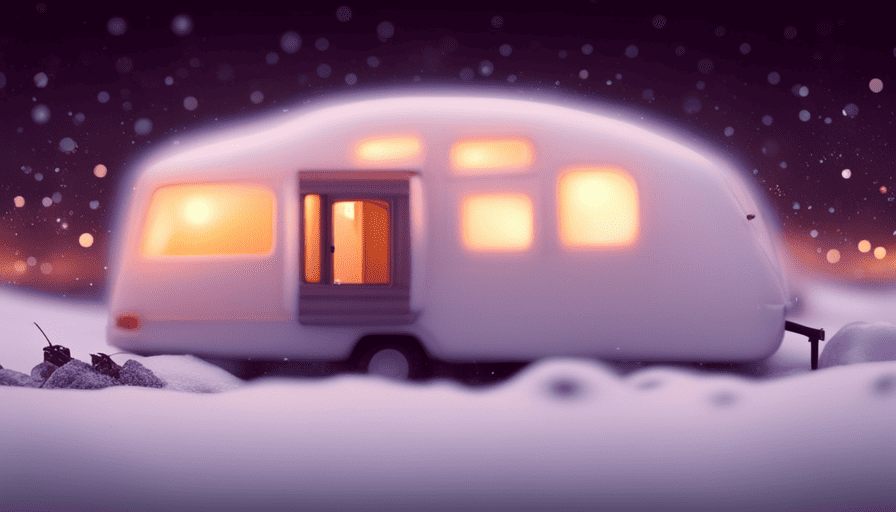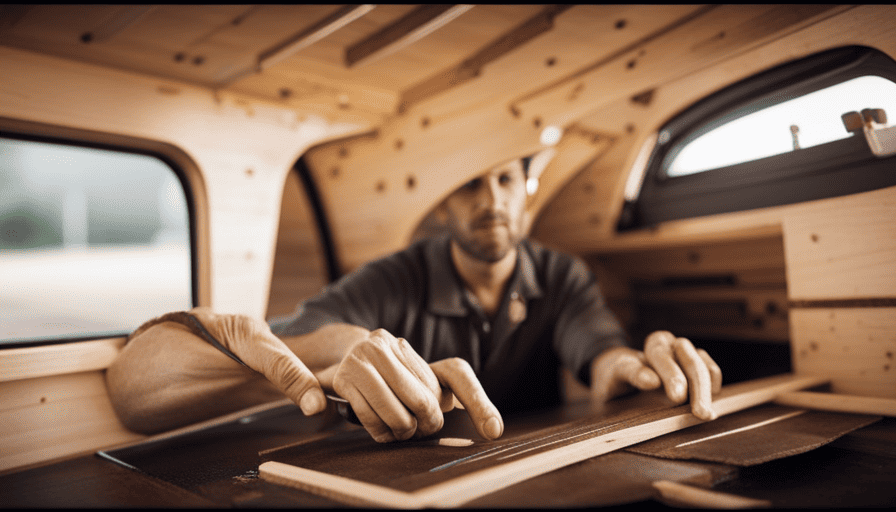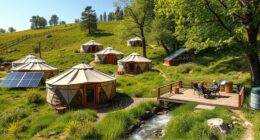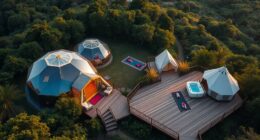Did you know that 87% of campers believe having access to hot water is vital for their camping experience?
Being able to enjoy a warm shower or a cup of tea can make a world of difference while out in the great outdoors.
But how can you get hot water in a camper? In this article, I will guide you through a variety of methods and options to ensure that you never have to go without hot water again.
From portable water heaters and solar shower bags to campfire heating and tankless water heaters, there are plenty of solutions to suit your needs and budget.
I will also provide tips on water conservation techniques and maintaining your water heating system to maximize efficiency.
So, let’s dive in and discover how to make your camping trips more comfortable with hot water in your camper.
Key Takeaways
- There are various methods and options available for getting hot water in a camper, including portable water heaters, solar shower bags, using a campfire or stove, and tankless water heaters.
- It is important to assess your needs and budget for hot water in a camper in order to choose the most suitable option.
- Insulating water storage tanks can maximize efficiency and help maintain desired shower temperatures.
- Regular maintenance and cleaning of the water heating system are crucial to ensure a consistent supply of hot water during camping adventures.
Assess Your Needs and Budget
Assessing your needs and budget is essential when figuring out how to get hot water in a camper. When planning for hot water in a camper, it’s important to consider different camping water storage options.
Depending on the size of your camper and the number of people using it, you may need to choose between different water storage tanks or containers. These can include portable water storage tanks, collapsible water jugs, or even built-in water tanks in larger campers.
In addition to water storage, exploring alternative heating methods for campers is crucial. While traditional propane water heaters are common, there are other options to consider. Solar water heaters, for example, utilize the energy from the sun to heat water. These can be a cost-effective and environmentally friendly option for campers who plan to spend a lot of time in sunny areas.
Consider portable water heaters as well. These compact devices can be easily installed in your camper and provide hot water on demand. They can run on propane, electricity, or even batteries, depending on your preferences and the available resources in your camper.
Transitioning into the next section, it’s important to consider portable water heaters as they offer convenience and efficiency in providing hot water for your camper.
Consider Portable Water Heaters
When considering portable water heaters for my camper, I’ve found two key options: propane water heaters and electric water heaters. Propane water heaters are a popular choice due to their efficiency and ability to provide hot water quickly. They’re powered by propane gas and can be easily connected to the camper’s propane tank.
On the other hand, electric water heaters are a convenient option for campers with access to electricity. They typically use a heating element to heat the water and can provide a continuous supply of hot water.
Both options have their advantages, and it’s important to assess my specific needs and budget before making a decision.
Propane Water Heaters
To get hot water in your camper, all you need is a propane water heater. Here’s why propane water heaters are a great choice:
-
Efficient: Propane water heaters heat water quickly and efficiently, allowing you to enjoy hot water in no time.
-
Versatile: Unlike electric water heaters, propane models can be used both on and off-grid, making them perfect for camping trips.
-
Cost-effective: Propane is generally cheaper than electricity, so using a propane water heater can help you save money in the long run.
-
Tankless option: Propane tankless water heaters provide hot water on demand, eliminating the need for a storage tank and saving space in your camper.
Now let’s dive into electric water heaters and explore their benefits.
Electric Water Heaters
Electric water heaters offer a reliable and convenient solution for heating water in your RV, but are they truly the most efficient option? When comparing electric water heaters to gas water heaters, there are a few key differences to consider.
Electric water heaters tend to be more energy efficient, as they only heat the water when it’s needed, whereas gas water heaters constantly maintain a set temperature. Additionally, electric water heaters eliminate the need for propane tanks, reducing the risk of running out of fuel while on the road.
Another benefit of electric water heaters is their compact size, allowing for easy installation in tight spaces. Finally, tankless electric water heaters provide an endless supply of hot water, making them ideal for extended trips. However, for those looking for an even more eco-friendly option, consider installing a solar shower bag.
Install a Solar Shower Bag
One effective way to ensure a refreshing hot shower while camping is by installing a solar shower bag. Solar shower bags are portable water heating devices that utilize the sun’s energy to warm up the water inside. They’re lightweight, easy to use, and perfect for outdoor enthusiasts who want to enjoy a hot shower on the go.
Here are three reasons why solar shower bags are a great choice for heating water while camping:
-
Convenience: Solar shower bags are designed to be portable and user-friendly. They usually come with a built-in handle and a hanging cord, allowing you to easily hang them in a sunny spot to heat up the water. This means you don’t have to rely on electricity or gas to get hot water in your camper.
-
Cost-effective: Solar shower bags are an affordable alternative to electric or gas water heaters. They’re relatively inexpensive to purchase and require no additional energy source apart from the sun. This makes them a cost-effective option for campers who want to save on energy bills.
-
Eco-friendly: Solar shower bags are environmentally friendly as they solely rely on solar power to heat the water. By using a solar shower bag, you reduce your carbon footprint and contribute to a greener planet.
Transitioning into the next section, another option for heating water while camping is to use a campfire or stove.
Use a Campfire or Stove for Heating Water
Now that we’ve discussed installing a solar shower bag in your camper, let’s explore another option for getting hot water – using a campfire or stove for heating water. This method is perfect for those who enjoy the traditional camping experience and want to utilize natural resources for their hot water needs.
Before you begin, it’s important to prioritize campfire safety. Make sure you have a designated fire pit and follow any regulations or guidelines set by the campground. Always keep a bucket of water nearby to extinguish the fire if needed.
When using a campfire or stove, you’ll need a pot or kettle suitable for heating water. Ensure that your stove is in good working condition and perform any necessary maintenance before use. Check for any gas leaks and clean the burners to ensure proper heat distribution.
To heat water on a campfire, place the pot or kettle on a stable surface above the flames. Use a tripod or grill grate to create a secure cooking area. Keep an eye on the water, as it can boil quickly over high heat.
Using a campfire or stove is a traditional and reliable way to heat water for your camping needs. However, if you’re looking for a more convenient and efficient option, it may be time to consider investing in a tankless water heater.
Invest in a Tankless Water Heater
Why settle for a traditional water heating method when you can experience the luxury of endless hot showers with a tankless water heater? When it comes to heating water in a camper, investing in a tankless water heater is a game-changer. Not only does it provide a portable option for hot water on the go, but it also offers exceptional energy efficiency.
Tankless water heaters work by heating water directly as it flows through the unit, eliminating the need for a storage tank. This means that hot water is available whenever you need it, without the need to wait for a tank to fill up or worry about running out of hot water. Additionally, tankless water heaters are highly energy efficient, as they only heat water as it’s needed, rather than constantly keeping a tank of water heated.
When it comes to portable options, tankless water heaters are a great choice. They’re compact in size and can easily be installed in a camper, providing hot water wherever you go. Furthermore, they’re designed to be durable and withstand the demands of outdoor use.
In the next section, we’ll discuss how to insulate your water storage tanks to further enhance the efficiency of your camper’s hot water system.
Insulate Your Water Storage Tanks
Make sure to insulate your water storage tanks to maximize the efficiency of your camper’s hot water system and keep your showers warm and comfortable. Insulating your water storage tanks is crucial, as it helps to minimize heat loss and maintain the desired temperature for a longer period of time. This is especially important in cold weather or when camping in colder regions.
There are various water heating options available for campers, but regardless of the type of heater you choose, insulating your water storage tanks will greatly improve its performance. The insulation material you use is also important, as it affects the overall insulation effectiveness. Common insulation materials include fiberglass, foam insulation, and reflective insulation.
Fiberglass insulation is a popular choice due to its high insulation properties and affordability. It’s easy to install and provides excellent thermal resistance. Foam insulation, on the other hand, offers superior insulation and can be customized to fit the shape of your water storage tanks. Reflective insulation is another option that reflects heat back into the tank, minimizing heat loss.
By insulating your water storage tanks, you can ensure that your camper’s hot water system operates efficiently, providing you with a constant supply of hot water. In the next section, we’ll discuss how to use a water heater conversion kit to further enhance your camper’s hot water capabilities.
Use a Water Heater Conversion Kit
To supercharge your camper’s hot water system, try using a water heater conversion kit that’ll take your showers from icy to scorching in the blink of an eye. When it comes to water heater alternatives for campers, a conversion kit is a game-changer.
This kit allows you to upgrade your existing water heater or install a new one, providing numerous benefits that’ll enhance your camping experience.
One of the main benefits of using a conversion kit is the ability to have hot water on demand. No more waiting for the water to heat up or worrying about running out of hot water during your shower. With a conversion kit, you can enjoy a continuous supply of hot water whenever you need it.
Another advantage is the increased efficiency of the water heating process. Conversion kits are designed to maximize energy transfer, meaning you can heat water faster and more efficiently. This not only saves you time but also reduces energy consumption, making it an environmentally friendly option.
Furthermore, conversion kits are relatively easy to install and require minimal maintenance. They typically come with detailed instructions and all the necessary components, making the installation process hassle-free.
Now that you’ve learned about the benefits of using a conversion kit, let’s explore another method to further enhance your camper’s hot water system: utilizing heat exchangers.
Utilize Heat Exchangers
Enhance your camping experience with the efficiency and convenience of heat exchangers, bringing a new level of comfort to your adventures. Heat exchangers are devices that transfer heat between two fluids, allowing you to heat water in your camper without the need for electricity or propane.
One of the main benefits of using a heat exchanger is its energy efficiency. By utilizing the waste heat from your engine’s cooling system, heat exchangers can effectively heat water while minimizing the use of additional resources. This not only saves you money but also reduces your environmental footprint.
When it comes to installing a heat exchanger in your camper, there are a few tips to keep in mind. First, make sure to choose a heat exchanger that is suitable for your camper’s size and water heating needs. Consider factors such as flow rate, pressure drop, and material compatibility.
Additionally, proper installation is crucial for optimal performance. Ensure that the heat exchanger is securely mounted and properly connected to your engine’s cooling system. It is also important to regularly inspect and maintain the heat exchanger to ensure its longevity and efficiency.
By utilizing heat exchangers in your camper, you can enjoy hot water on demand while minimizing energy consumption. This efficient water heating solution seamlessly integrates into your camper’s existing systems, providing you with the comfort and convenience you desire.
In the next section, we will explore various water conservation techniques that complement your heat exchanger setup.
Practice Water Conservation Techniques
Save water and reduce your environmental impact by implementing water conservation techniques while camping – did you know that even small changes can make a big difference? Here are some water-saving tips and eco-friendly water solutions to help you get hot water in your camper while minimizing your water usage.
-
Install a low-flow showerhead: By using a low-flow showerhead, you can reduce your water consumption by up to 50% without compromising on the water pressure. This simple change can save gallons of water during each shower.
-
Use a water-saving faucet aerator: A faucet aerator is a device that mixes air with the water, reducing the flow rate without affecting the water pressure. Installing a water-saving faucet aerator can help you save water every time you wash your hands or do dishes.
-
Collect and reuse water: Instead of letting the water run while waiting for it to heat up, collect the cold water in a container and use it for other purposes like washing dishes or flushing the toilet. This way, you avoid wasting water and make the most out of every drop.
By incorporating these water conservation techniques, you can enjoy hot water in your camper while minimizing your water usage and environmental impact. To ensure the efficiency of your water heating system, it’s important to regularly maintain and clean it.
Regularly Maintain and Clean Your Water Heating System
To ensure a steady supply of hot water in your camper, it’s crucial to regularly maintain and clean your water heating system. By doing so, you can assess its efficiency and troubleshoot common issues that may arise.
Firstly, conducting routine maintenance on your water heating system is essential. This involves inspecting the heater for any signs of wear or damage, such as leaks or rust. Additionally, you should check the pressure relief valve and ensure it’s functioning correctly. If any issues are identified during this assessment, it’s important to address them promptly to prevent further damage.
In terms of cleaning, flushing out the water heater tank periodically is highly recommended. Sediment and mineral deposits can accumulate over time, reducing the system’s efficiency. By draining and flushing the tank, you can remove these deposits and optimize the performance of your water heating system.
Furthermore, when troubleshooting common issues, it’s essential to follow the manufacturer’s guidelines. This may include checking the gas or electric supply, examining the thermostat settings, or inspecting the ignition system. By systematically identifying and resolving these problems, you can maintain a reliable source of hot water in your camper.
Regularly maintaining and cleaning your water heating system is vital for assessing its efficiency and troubleshooting common issues. By following these steps, you can ensure a consistent supply of hot water throughout your camping adventures.
Frequently Asked Questions
How much does a portable water heater cost?
A portable water heater can cost anywhere between $50 to $500, depending on the features and brand. These heaters offer numerous benefits, such as convenience and efficiency. They are compact and easy to transport, making them ideal for camping or other outdoor activities.
Portable water heaters typically have adjustable temperature settings and can provide hot water quickly. Some models even come with safety features like automatic shutoff and low water pressure protection.
Can I use a solar shower bag in cold weather?
Yes, a solar shower bag can be used in cold weather, but it may not provide hot water. Solar shower bags rely on sunlight to heat the water, so during colder months when there is less sunlight, the water may not reach the desired temperature.
However, there are alternative solutions for heating water in cold weather such as using a propane water heater or installing a tankless water heater system in your camper. These heating options can provide consistent hot water regardless of the weather conditions.
Can I use a tankless water heater in any type of camper?
Using a tankless water heater in a camper has its pros and cons. The main advantage is its ability to provide hot water on demand, without the need for a storage tank. This saves space and allows for unlimited hot water supply. However, a tankless water heater typically runs on propane, which can be expensive and require regular refilling.
Alternative options for heating water in a camper include solar water heaters, electric water heaters, and portable camping showers.
How do I insulate my water storage tanks?
To insulate water storage tanks in a camper, I use various techniques to prevent heat loss. First, I apply foam insulation around the tanks, creating a barrier that minimizes thermal conductivity.
Next, I wrap the tanks with insulating blankets, providing an additional layer of protection.
Finally, I ensure all connections and openings are sealed tightly to avoid any air leakage. These insulating techniques are crucial for maintaining hot water temperature in a camper.
How often should I clean and maintain my water heating system?
I clean and maintain my water heating system regularly to ensure optimal performance. To descale the water heater, I follow the manufacturer’s recommendations and typically do it every 3-6 months. This helps remove mineral deposits that can affect efficiency.
Additionally, I extend the lifespan of my water heater by flushing the tank annually and checking for any leaks or signs of corrosion. These tips ensure a reliable and efficient water heating system.
Conclusion
In conclusion, obtaining hot water in a camper can be achieved through various methods and technologies. By carefully assessing your needs and budget, you can choose the most suitable option.
Portable water heaters, solar shower bags, and utilizing campfires or stoves are all effective solutions. Investing in a tankless water heater or using a water heater conversion kit can provide long-term convenience. Heat exchangers and water conservation techniques are also worth considering.
Lastly, regular maintenance and cleaning of your water heating system will ensure its optimal performance. So, go ahead and enjoy hot showers on your camping adventures, because who says roughing it means sacrificing comfort?

